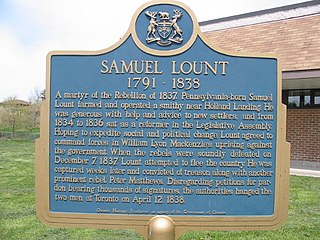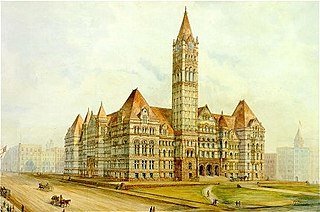
The Province of Upper Canada was a part of British Canada established in 1791 by the Kingdom of Great Britain, to govern the central third of the lands in British North America, formerly part of the Province of Quebec since 1763. Upper Canada included all of modern-day Southern Ontario and all those areas of Northern Ontario in the Pays d'en Haut which had formed part of New France, essentially the watersheds of the Ottawa River or Lakes Huron and Superior, excluding any lands within the watershed of Hudson Bay. The "upper" prefix in the name reflects its geographic position along the Great Lakes, mostly above the headwaters of the Saint Lawrence River, contrasted with Lower Canada to the northeast.

William Lyon Mackenzie was a Scottish Canadian-American journalist and politician. He founded newspapers critical of the Family Compact, a term used to identify elite members of Upper Canada. He represented York County in the Legislative Assembly of Upper Canada and aligned with Reformers. He led the rebels in the Upper Canada Rebellion; after its defeat, he unsuccessfully rallied American support for an invasion of Upper Canada as part of the Patriot War. Although popular for criticising government officials, he failed to implement most of his policy objectives. He is one of the most recognizable Reformers of the early 19th century.

The Upper Canada Rebellion was an insurrection against the oligarchic government of the British colony of Upper Canada in December 1837. While public grievances had existed for years, it was the rebellion in Lower Canada, which started the previous month, that emboldened rebels in Upper Canada to revolt.

The Family Compact was a small closed group of men who exercised most of the political, economic and judicial power in Upper Canada from the 1810s to the 1840s. It was the Upper Canadian equivalent of the Château Clique in Lower Canada. It was noted for its conservatism and opposition to democracy.

A debtors' prison is a prison for people who are unable to pay debt. Until the mid-19th century, debtors' prisons were a common way to deal with unpaid debt in Western Europe. Destitute people who were unable to pay a court-ordered judgment would be incarcerated in these prisons until they had worked off their debt via labour or secured outside funds to pay the balance. The product of their labour went towards both the costs of their incarceration and their accrued debt. Increasing access and lenience throughout the history of bankruptcy law have made prison terms for unaggravated indigence obsolete over most of the world.

The Bank of Upper Canada was established in 1821 under a charter granted by the legislature of Upper Canada in 1819 to a group of Kingston merchants. The charter was appropriated by the more influential Executive Councillors to the Lt. Governor, the Rev. John Strachan and William Allan, and moved to Toronto. The bank was closely associated with the group that came to be known as the Family Compact, and it formed a large part of their wealth. The association with the Family Compact and its underhanded practices made Reformers, including Mackenzie, regard the Bank of Upper Canada as a prop of the government. Complaints about the bank were a staple of Reform agitation in the 1830s because of its monopoly and aggressive legal actions against debtors.

The Bank of the People was created by radical Reform politicians James Lesslie, James Hervey Price, and Dr John Rolph in Toronto in 1835. It was founded after they failed to establish a "Provincial Loan Office" in which farmers could borrow small sums guaranteed by their land holdings. The Bank of the People was the only bank in Upper Canada not to suspend payments during the financial panic of 1837-8. Many of the shareholders, however, took part in the Rebellion of 1837 and the Family Compact plotted to have it taken over by the Bank of Montreal in 1840.

Samuel Lount was a blacksmith, farmer, magistrate and member of the Legislative Assembly in the province of Upper Canada for Simcoe County from 1834 to 1836. He was an organizer of the failed Upper Canada Rebellion of 1837, for which he was hanged as a traitor. His execution made him a martyr to the Upper Canadian Reform movement.
The history of Roman law can be divided into three systems of procedure: that of legis actiones, the formulary system, and cognitio extra ordinem. Though the periods in which these systems were in use overlapped one another and did not have definitive breaks, the legis actio system prevailed from the time of the XII Tables until about the end of the 2nd century BC, the formulary procedure was primarily used from the last century of the Republic until the end of the classical period, and cognitio extra ordinem was in use in post-classical times.
Henry John Boulton, was a lawyer and political figure in Upper Canada and the Province of Canada, as well as Chief Justice of Newfoundland.
Robert Randal was a businessman and political figure in Upper Canada and the United States. He was born in the United States and convicted of attempting to bribe members of the United States Congress in order to buy the lower Michigan peninsula. He bought mills and acres of land in Upper Canada. However, his businesses were unsuccessful and sold to British creditors. He was arrested in Montreal and he was sued for unpaid debts. He hired G. D'Arcy Boulton as his lawyer to protect his properties, but the delay in court proceedings put him in debt with the lawyers, causing more of his properties to be sold to pay his debts.

Diligence is a term in Scots Law with no single definition, but is commonly used to describe debt collection and debt recovery proceedings against a debtor by a creditor in Scottish courts. The law of diligence is part of the law of actions in Scots private law. Accordingly, it is within the devolved competence of the Scottish Parliament.
Civil procedure in South Africa is the formal rules and standards that courts follow in that country when adjudicating civil suits. The legal realm is divided broadly into substantive and procedural law. Substantive law is that law which defines the contents of rights and obligations between legal subjects; procedural law regulates how those rights and obligations are enforced. These rules govern how a lawsuit or case may be commenced, and what kind of service of process is required, along with the types of pleadings or statements of case, motions or applications, and orders allowed in civil cases, the timing and manner of depositions and discovery or disclosure, the conduct of trials, the process for judgment, various available remedies, and how the courts and clerks are to function.

The Reform movement in Upper Canada was a political movement in British North America in the mid-19th century.

The Farmers’ Storehouse was Canada's first farmers' cooperative, founded in Toronto and the Home District in 1824. It stood at the centre of a broad economic and political reform movement that, in its essentials, was not greatly different from contemporary movements such as the Owenite socialists in Britain, as well as much later cooperative movements such as the United Farmers of Alberta in the early twentieth century.

Upper Canada had few exports with which to pay for its imported manufactured needs. For those who settled in rural areas, debt could be paid off only through the sale of wheat and flour. However, for much of the 1820s, the price of wheat went through cycles of boom and bust depending upon the British markets that ultimately provided the credit upon which the farmer lived.

There were two types of corporations at work in the Upper Canadian economy: the legislatively chartered companies and the unregulated joint stock companies. These two business forms had different legal standing; chartered corporations had a "separate personality" - they were a legal person quite distinct from its members or shareholders, a legal fiction which protected those shareholders with limited liability. In contrast, joint stock companies were made illegal by the English Bubble Act of 1720. Joint stock companies were considered extensive partnerships under common law, and English legislation limited these to a maximum of six partners. Without incorporation, the company was not considered a "separate personality." It could not hold property; this was held by trustees, who usually had to provide a bond or security. Without incorporation, the company could neither sue nor be sued at law. And without incorporation, shareholders were personally responsible for the debts to the company to the full extent of their personal property; shareholders were not protected by limited liability. There were, then, significant legal hurdles that made the joint stock company an unwieldy form of partnership.
Insolvency in South African law refers to a status of diminished legal capacity imposed by the courts on persons who are unable to pay their debts, or whose liabilities exceed their assets. The insolvent's diminished legal capacity entails deprivation of certain of his important legal capacities and rights, in the interests of protecting other persons, primarily the general body of existing creditors, but also prospective creditors. Insolvency is also of benefit to the insolvent, in that it grants him relief in certain respects.

The Bankruptcy Act of 1800 was the first piece of federal legislation in the United States surrounding bankruptcy. The act was passed in response to a decade of periodic financial crises and commercial failures. It was modeled after English practice. The act placed the bankrupt estate under the control of a commissioner chosen by the district judge. The debt would be forgiven if two-thirds of creditors agreed to forgive the remaining debt. Only merchants could petition a creditor to file a case under the provisions of the act.
The Types Riot was the destruction of William Lyon Mackenzie's printing press and movable type by members of the Family Compact on June 8, 1826, in York, Upper Canada. The Family Compact was the ruling elite of Upper Canada who appointed themselves to positions of power within the Upper Canadian government. Mackenzie created the Colonial Advocate newspaper and published editorials in the paper that accused the Family Compact of incompetence and profiteering on corrupt practices, offending the rioters. It is not known who planned the riot, although Samuel Jarvis, a government official, later claimed he organized the event. On the evening of June 8, 9–15 rioters forced their way into the newspaper offices and destroyed property. During the event, Mackenzie's employees tried to get passersby to help stop the rioters. Bystanders refused to help when they saw government officials like William Allan and Stephen Heward were watching the spectacle. When the rioters finished destroying the office, they took cases of type with them and threw them into the nearby bay.













